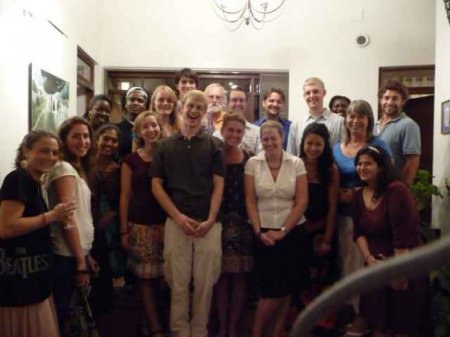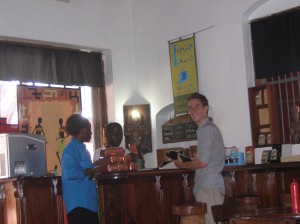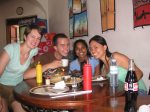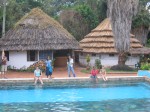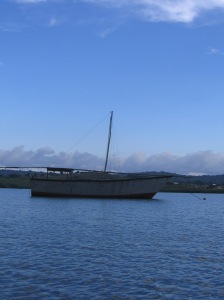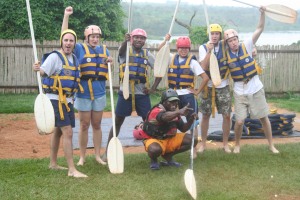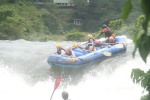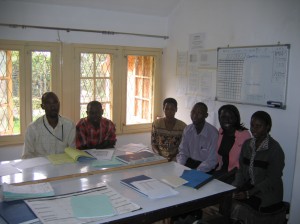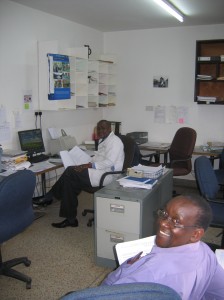After my daily morning research study team meeting on Friday, I met some Makerere University medical student leaders from the Students in Equity for Health Care (SEHC) chapter. The chapter has its Week of Action coming up on May 4-9, 2009, and I have been attending some of their organizing meetings.
The SEHC Week of Action is similar to the ones put together in the U.S. from the student chapters of Physicians for Human Rights. In fact, when I was chapter president of PHR in 2006-2007, we sent some money we fundraised to PHR explicitly for the SEHC chapter in Uganda. The week will consist of lunch time hours talks around advocacy and health & human rights issues in Uganda and community volunteer time in Katanga on Friday, May 8.
I went with SEHC members Herbert, Juliet, and Diana to visit a school in the Katanga settlement, a slum literally across the street from Mulago hospital. The SEHC students sponsor a weekly Friday porridge meal for the children and are looking to increase their involvement in the community even more with this year’s Week of Action focused on the children of Katanga. The experience reminded us once again of the immense poverty and challenges of the poorest Ugandans.
Here is a concise background of BEUPA and this particular BEUPA school, which is one of about 75 in Kampala District. This information comes from a proposal/protocol prepared by SEHC for Bucknell University’s undergraduate Globemed chapter:
Background of BEUPA
BEUPA is a learning centre found in Katanga providing basic education to direly indigent children. The centre was started by Kampala City Council (KCC) in conjunction with GTZ, a German Development Cooperation in 2000. However, this GTZ – KCC venture was only a five 5 year program ending in 2005. After the end of the venture, the BEUPA project was handed over to the community in Katanga. Katanga being a slum, it is inhabited by majority of people living below the poverty line (living on less than US$ 1 a day). The people therefore are in continuous socioeconomic crisis and could not maintain the project. From 2006 to date, the BEUPA is being run by a volunteer family, which is also at the moment almost giving it up.
From the inception of BEUPA to date, they have been providing basic education in Mathematics, English and literacy with an aim of imparting basic knowledge to the children. The children are divided into three groups depending on the age groups, and more so, how knowledgeable they are when they report to BEUPA. These groups are in three classes. Class I is a beginners class, Class II for intermediates, and Class III for those portraying an above average literacy potential.
Background on the children at BEUPA
The total number of children at BEUPA varies from 50 – 100 pupils aged between 5 and 17 years of age. Due to their poor socio-economic background, these children cannot afford the Universal Primary Education (UPE) that is not apparently free as it was stipulated to be in Uganda.
Majority of these children are orphaned by or are living with HIV/AIDS, with some of them being the eldest children at their homes thereby having to head or take care of their families. Most of them are casual labourers, working part of the day, to supplement income for their families. The average child starts to work at the tender age of 8, being involved various activities jobs like collecting scrap metal for sell or selling foodstuffs on the street.
Receiving a single meal in a week at BEUPA, the highest attendance at BEUPA is noted that day. The children come with firewood to cook the porridge. The maximum attendance is noted that day a cup of porridge is served for the children at BEUPA. This is because majority of the children live on only one meal a day (usually supper), and the day they are served with porridge is the only day of at least two meals. The meal served is just, made of just 3kgs of maize flour to feed the entire population of the children attending that day at BEUPA.
The centre is run by three volunteer teachers from the community. The volunteer teachers open the centre in the morning and close at noon, particularly because majority of the children come to school when hungry and cannot stay till evening on an empty stomach.
The story runs a bit deeper. GTZ pulled out in 2005 because KCC misused the aid money. The city council then became the sponsor of Katanga BEUPA school. At first KCC distributed a 50,000/= (~25) monthly “allowance” to the school but that ceased in 2006. Since then the teachers have been essentially volunteers. They have been promised to be put on a government payroll; however, this payment has not come to fruition. Unsurprisingly, KCC has not been able to find any outside donors.
The teachers in part credit Joseph, a previous SEHC president, and SEHC writ large as two of the reasons why they are still there. He came across the Katanga school and mobilized more Makerere health professional students to get involved with activities like soup kitchens and distribution of clothes donations to the children. Subsequently, the SEHC chapter formally committed to the community.
We met two teachers, Janet and “Hajjit,” who are volunteer teachers. They said the biggest challenges for them come from kids from the poorest families in Katanga. These children typically eat one meal per day at 6PM, if that. Since they do not eat in the morning, they often fall asleep during class and have short attention spans because they are hungry. The children study up till noon and then go home for the day. Normally, they would be going home for lunch and then return, but since many do not get lunch and because the school has no funding, the day is only 1/2 day long.
The class used to be 60-80 students in size but after the necessity to introduce a quarterly fee of 5,000/= (~$2.50) per student the class size dwindled to the current 40 children. Yes, even $2.50 was too much for some children’s families or school was not enough of a priority in light of another needs or uses of money.
During our meeting with Janet and Hajjit, we met a Katanga resident, “Hajj” (a common nickname given to Muslim men here), who had generously donated the land on which the school was built. He has kept the land free as long as the school continues to be productive in light of its constraints. A kind, slight man, we all thanked him for his generosity and he thanked the SEHC students for their work.
The school technically can teach students 5-18 years old but most of them are at the younger end of the spectrum. Janet and Hajjit were explaining to us how the adolescents do not come, in part because they feel shame for not being able to read and write at their ages. Additionally, children need to find work at a young age as you read in the background, often collecting metal scraps for money in some rough parishes and zones of Kampala.
Originally, one of the long term goals for these children was to streamline them into vocational technical work. The teachers even had apprenticeships lined up for that segment of education after school years 1-3. But BEUPA Katanga did not have funds to pay the vo-tech trainers, so this idea went unrealized and the kids have since had to fend from themselves.
Some children when they finish the BEUPA school graduated into P5 of the UPE (the supposedly “free” education) and move upwards, but they are few. As we walked to the school, children who should have been in school were running all around having a fun time with friends. Many live with relatives who came to Kampala with parents living in the villages. Others are orphans. Most are low priorities in terms of access to family support.
Micronutrient deficiences, lack of access to funded education, and non-ideal family situations are among the barriers these children face. At one point I saw a likely drunk/high adolescent girl swaying outside a window of the school, eyes staring me glazed with an awkward smile. The kids in the class were joyful but a bit restless. These teachers and kids deserve more resources.
SEHC has the following objectives in its proposal:
Broad objective
To improve the functionality of the BEUPA project
Specific Objectives
1. To improve the delivery of basic education at BEUPA, by providing material support, and intellectual support
2. To regularize the attendance of children at BEUPA, by providing at least a daily cup of porridge
3. To improve the health status of the children at BEUPA through VCT, de-worming, and provision of basic diagnosis and medication
4. To pave way for a constructive exit strategy for the children at BEUPA
Walking around Katanga, I kept seeing an all too familiar scenario. Immense poverty, raw sewage, children running around, overcrowding and a muddy landscape that rain storms probably wreak havoc upon every time. And like in Nairobi or in major cities in Brazil, India, etc., these slums are minutes away from the opposite end of the economic spectrum. Garden City mall is 2 minutes drive down the road bordering Katanga and Mulago Hospital. I go to the gym there, watch movies at the cinema, and often eat and shop. Traveling from Katanga to Garden City the road is flanked by the two wealthiest parishes of Kampala, Nakasero and Kololo. Poverty may hide sometimes, but it is not far away.
BEUPA Katanga relies on the generosity of others. I myself believe in the power and place of civic action and the work of groups like SEHC in the poorest places. But the honest truth is that SEHC should not need to exist if the public sector worked more equitably in the health and education realms. Educated and healthy people would be more likely to succeed and have a chance to be upwardly mobile in the business, service, and manufacturing sectors. This realization of the common good in these areas (and I say this as the debate continues in my own country) has not yet been actualized and corruption and avoidable inefficiencies are partly to blame for the present situation in Katanga.
Thankfully, SEHC does exist in light of reality. If you are interested in helping SEHC’s work financially or gifts-in-kind (chalk, crayons, basic English and math workbooks) let me know and I can get you in touch with AGHA (Action Group for Health, Human Rights, and HIV/AIDS) for coordination, a Ugandan partner with Physicians for Human Rights that I have worked with on medication stock-out campaign and leadership training institute, the latter which I will blog about soon. I can also forward on SEHC’s proposal. I hope to go back to this Katanga school before I leave Uganda this time, and if so, I will take pictures.
